Abstract
In the past decade, there has been considerable emphasis on developing and refining the measurement instruments used to assess the rewarding effect of brain stimulation. These efforts have given rise to quantitative methods aimed at revealing the underlying neurophysiology and neuroanatomy by tracing the trajectories of the relevant neurons. In this paper, we summarize some of the quantitative findings that have resulted from research at the University of Ottawa in the neurobiology of motivated behavior. These include studies using markers to reveal which structures are metabolically activated by rewarding brain stimulation, comprehensive mapping of brain areas for self-stimulation and other stimulation-induced behaviors, and examination of the effects of benzodiazepines on feeding and reward.
Full text
PDF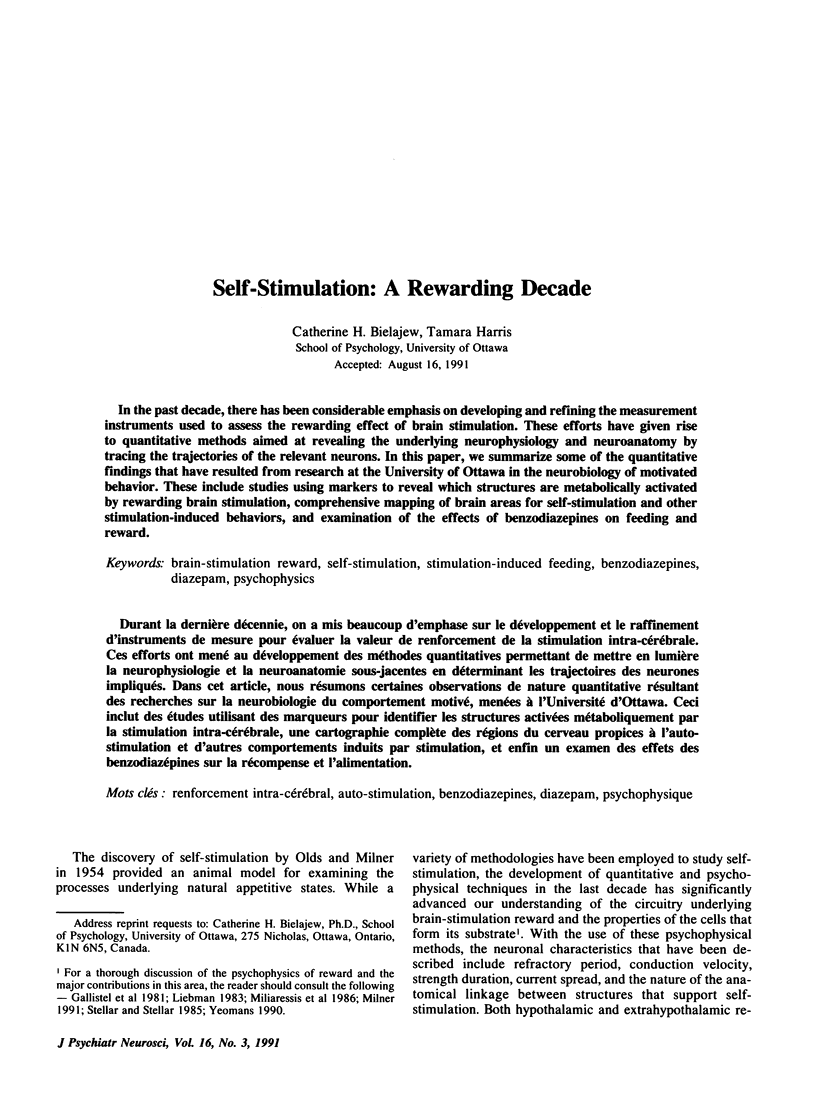
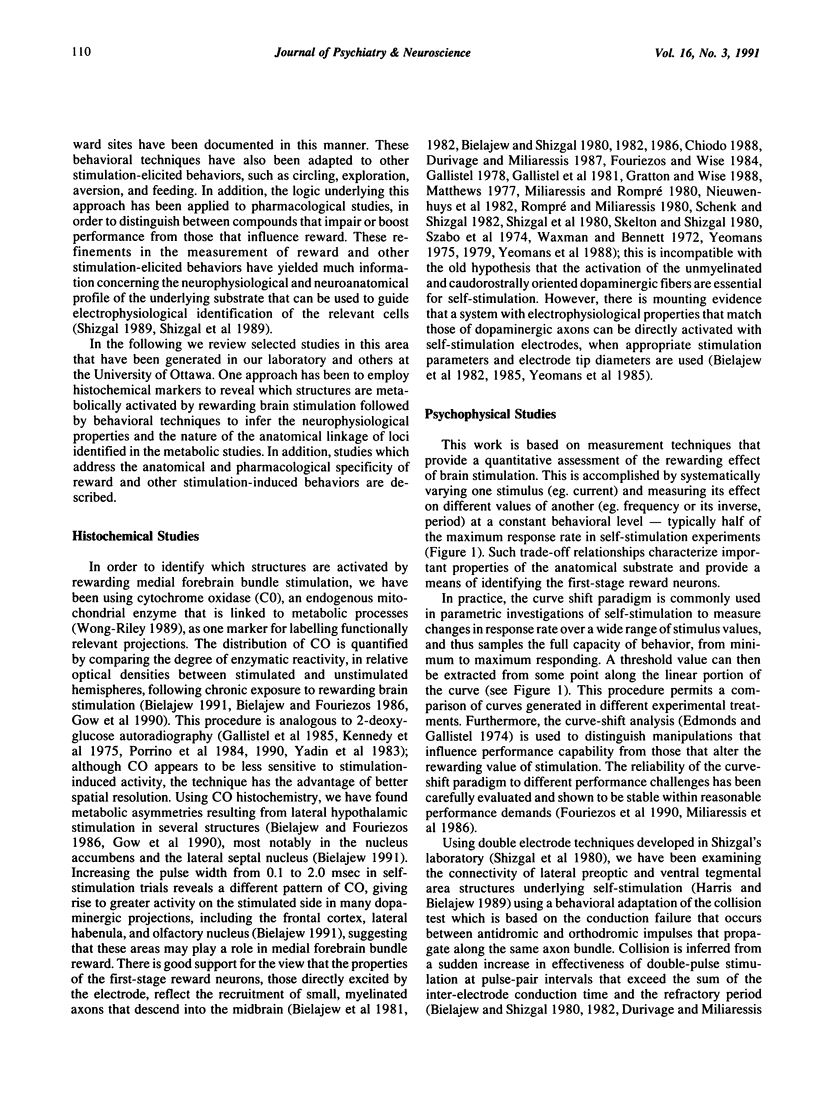
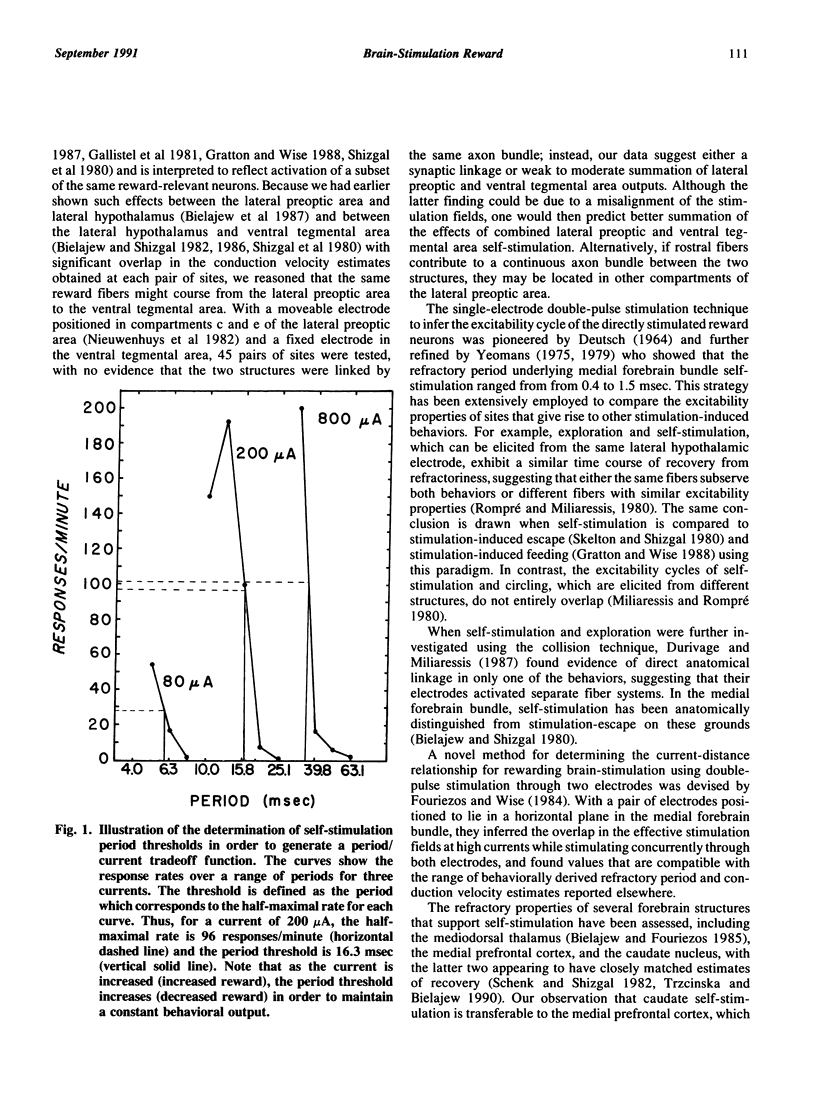
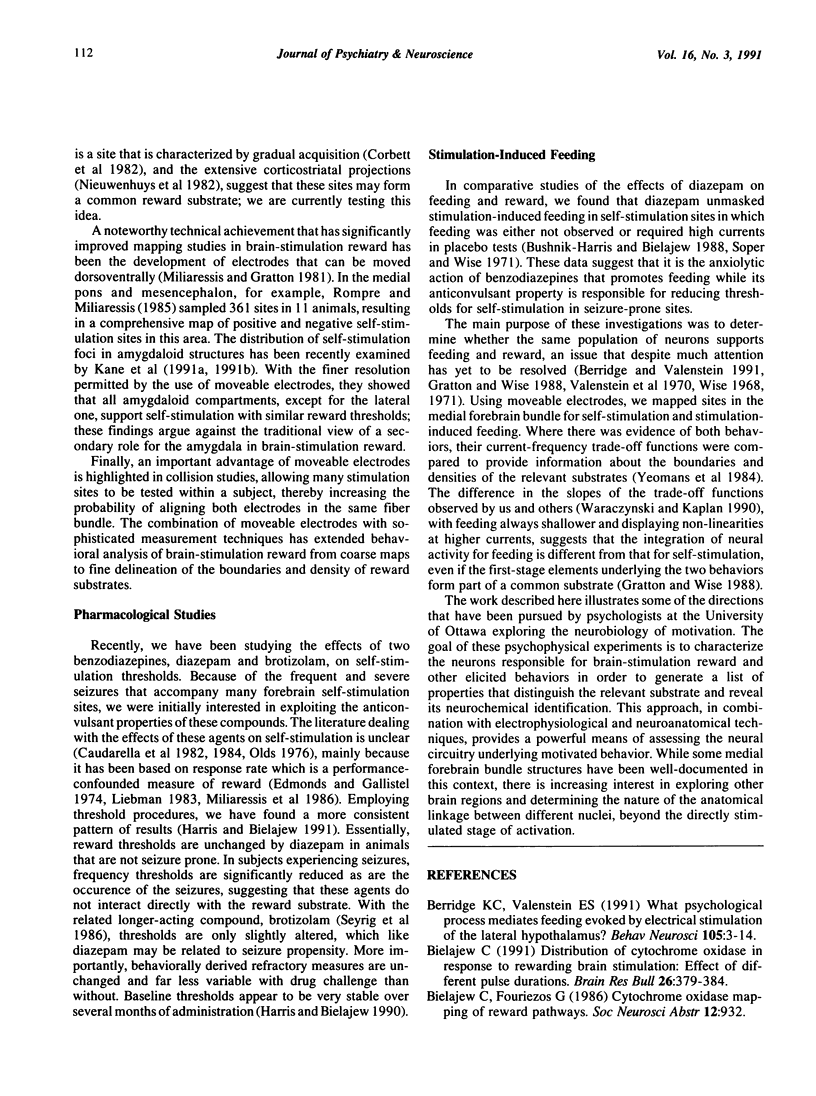
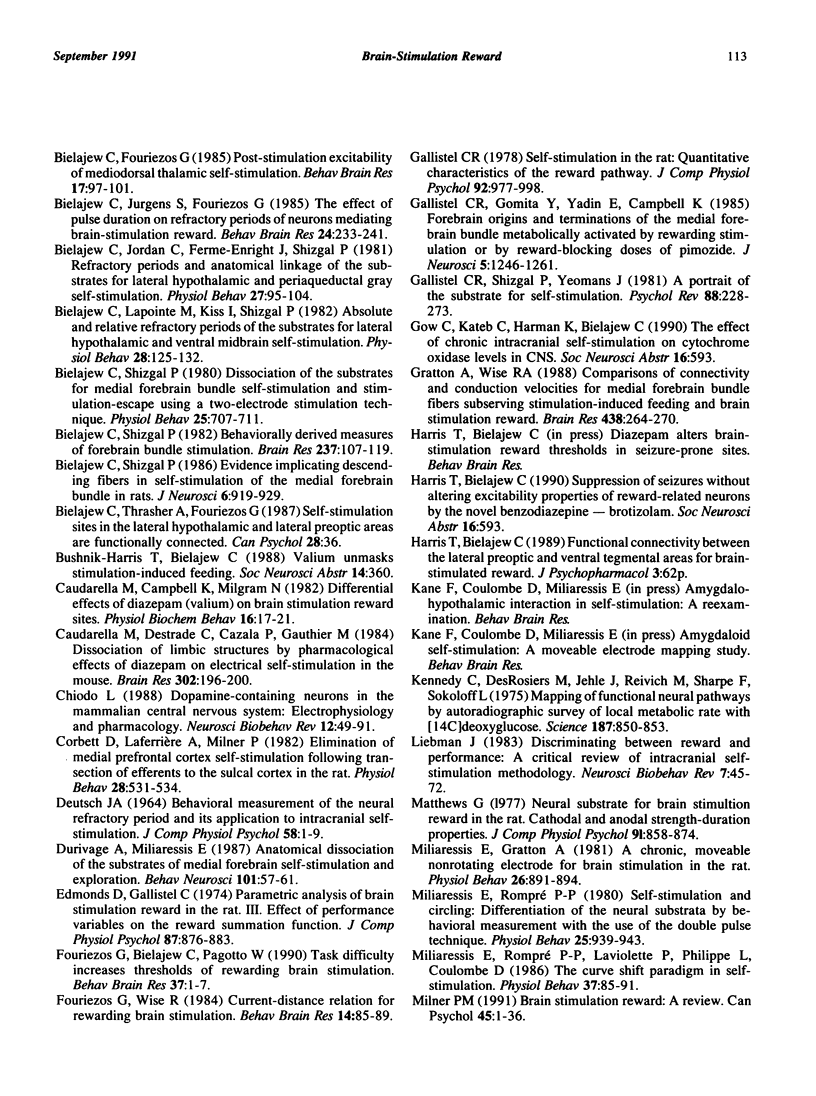
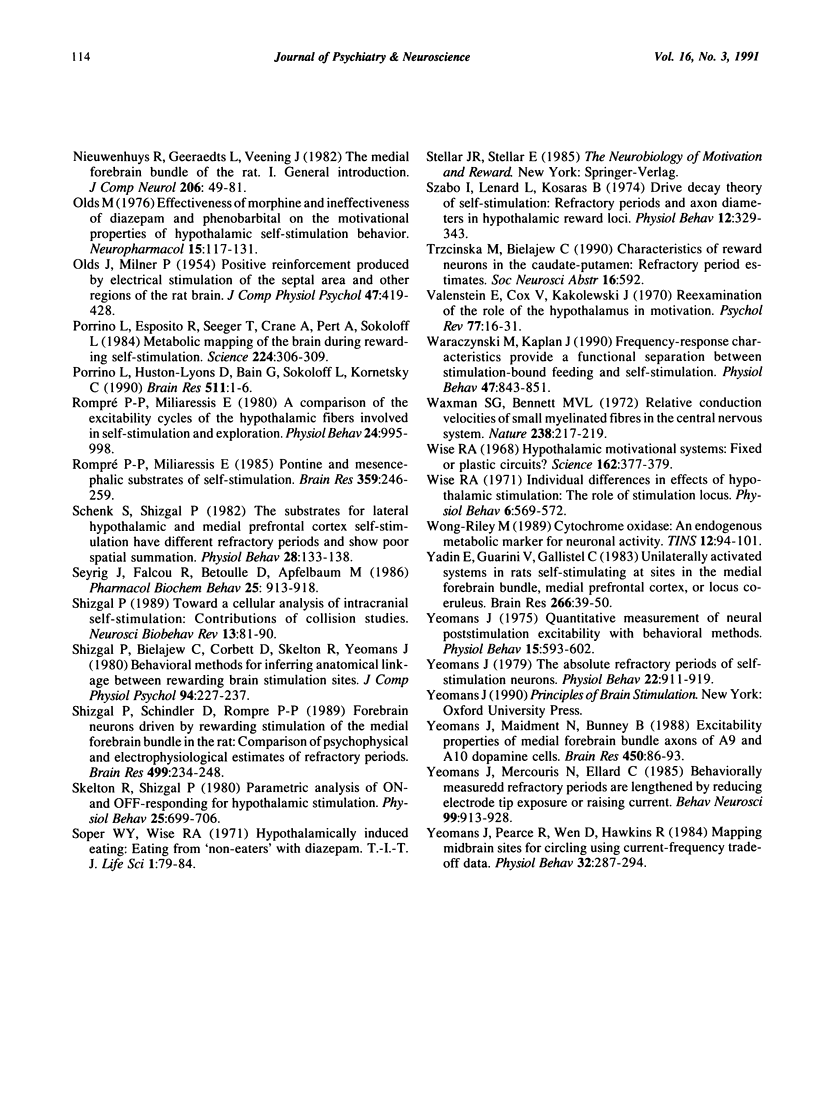
Selected References
These references are in PubMed. This may not be the complete list of references from this article.
- Berridge K. C., Valenstein E. S. What psychological process mediates feeding evoked by electrical stimulation of the lateral hypothalamus? Behav Neurosci. 1991 Feb;105(1):3–14. doi: 10.1037//0735-7044.105.1.3. [DOI] [PubMed] [Google Scholar]
- Bielajew C. H. Distribution of cytochrome oxidase in response to rewarding brain stimulation: effect of different pulse durations. Brain Res Bull. 1991 Mar;26(3):379–384. doi: 10.1016/0361-9230(91)90010-h. [DOI] [PubMed] [Google Scholar]
- Bielajew C., Fouriezos G. Post-stimulation excitability of mediodorsal thalamic self-stimulation. Behav Brain Res. 1985 Sep-Oct;17(2):97–101. doi: 10.1016/0166-4328(85)90022-1. [DOI] [PubMed] [Google Scholar]
- Bielajew C., Jordan C., Ferme-Enright J., Shizgal P. Refractory periods and anatomical linkage of the substrates for lateral hypothalamic and periaqueductal gray self-stimulation. Physiol Behav. 1981 Jul;27(1):95–104. doi: 10.1016/0031-9384(81)90305-x. [DOI] [PubMed] [Google Scholar]
- Bielajew C., Jurgens S., Fouriezos G. The effect of pulse duration of refractory periods of neurons mediating brain-stimulation reward. Behav Brain Res. 1987 Jun;24(3):233–241. doi: 10.1016/0166-4328(87)90061-1. [DOI] [PubMed] [Google Scholar]
- Bielajew C., Lapointe M., Kiss I., Shizgal P. Absolute and relative refractory periods of the substrates for lateral hypothalamic and ventral midbrain self-stimulation. Physiol Behav. 1982 Jan;28(1):125–132. doi: 10.1016/0031-9384(82)90113-5. [DOI] [PubMed] [Google Scholar]
- Bielajew C., Shizgal P. Behaviorally derived measures of conduction velocity in the substrate for rewarding medial forebrain bundle stimulation. Brain Res. 1982 Apr 8;237(1):107–119. doi: 10.1016/0006-8993(82)90560-1. [DOI] [PubMed] [Google Scholar]
- Bielajew C., Shizgal P. Dissociation of the substrates for medial forebrain bundle self-stimulation and stimulation-escape using a two-electrode stimulation technique. Physiol Behav. 1980 Nov;25(5):707–711. doi: 10.1016/0031-9384(80)90373-x. [DOI] [PubMed] [Google Scholar]
- Bielajew C., Shizgal P. Evidence implicating descending fibers in self-stimulation of the medial forebrain bundle. J Neurosci. 1986 Apr;6(4):919–929. doi: 10.1523/JNEUROSCI.06-04-00919.1986. [DOI] [PMC free article] [PubMed] [Google Scholar]
- Caudarella M., Campbell K. A., Milgram N. W. Differential effects of diazepam (valium) on brain stimulation reward sites. Pharmacol Biochem Behav. 1982 Jan;16(1):17–21. doi: 10.1016/0091-3057(82)90006-5. [DOI] [PubMed] [Google Scholar]
- Caudarella M., Destrade C., Cazala P., Gauthier M. Dissociation of limbic structures by pharmacological effects of diazepam on electrical self-stimulation in the mouse. Brain Res. 1984 Jun 4;302(1):196–200. doi: 10.1016/0006-8993(84)91301-5. [DOI] [PubMed] [Google Scholar]
- Chiodo L. A. Dopamine-containing neurons in the mammalian central nervous system: electrophysiology and pharmacology. Neurosci Biobehav Rev. 1988 Spring;12(1):49–91. doi: 10.1016/s0149-7634(88)80073-3. [DOI] [PubMed] [Google Scholar]
- Corbett D., Laferriere A., Milner P. M. Plasticity of the medial prefrontal cortex: facilitated acquisition of intracranial self-stimulation by pretraining stimulation. Physiol Behav. 1982 Mar;28(3):531–534. doi: 10.1016/0031-9384(82)90151-2. [DOI] [PubMed] [Google Scholar]
- DEUTSCH J. A. BEHAVIORAL MEASUREMENT OF THE NEURAL REFRACTORY PERIOD AND ITS APPLICATION TO INTRACRANIAL SELF-STIMULATION. J Comp Physiol Psychol. 1964 Aug;58:1–9. doi: 10.1037/h0045582. [DOI] [PubMed] [Google Scholar]
- Durivage A., Miliaressis E. Anatomical dissociation of the substrates of medial forebrain bundle self-stimulation and exploration. Behav Neurosci. 1987 Feb;101(1):57–61. doi: 10.1037//0735-7044.101.1.57. [DOI] [PubMed] [Google Scholar]
- Edmonds D. E., Gallistel C. R. Parametric analysis of brain stimulation reward in the rat: III. Effect of performance variables on the reward summation function. J Comp Physiol Psychol. 1974 Nov;87(5):876–883. doi: 10.1037/h0037217. [DOI] [PubMed] [Google Scholar]
- Fouriezos G., Bielajew C., Pagotto W. Task difficulty increases thresholds of rewarding brain stimulation. Behav Brain Res. 1990 Feb 12;37(1):1–7. doi: 10.1016/0166-4328(90)90066-n. [DOI] [PubMed] [Google Scholar]
- Fouriezos G., Wise R. A. Current-distance relation for rewarding brain stimulation. Behav Brain Res. 1984 Oct;14(1):85–89. doi: 10.1016/0166-4328(84)90023-8. [DOI] [PubMed] [Google Scholar]
- Gallistel C. R., Gomita Y., Yadin E., Campbell K. A. Forebrain origins and terminations of the medial forebrain bundle metabolically activated by rewarding stimulation or by reward-blocking doses of pimozide. J Neurosci. 1985 May;5(5):1246–1261. doi: 10.1523/JNEUROSCI.05-05-01246.1985. [DOI] [PMC free article] [PubMed] [Google Scholar]
- Gallistel C. R. Self-stimulation in the rat: quantitative characteristics of the reward pathway. J Comp Physiol Psychol. 1978 Dec;92(6):977–998. doi: 10.1037/h0077513. [DOI] [PubMed] [Google Scholar]
- Gallistel C. R., Shizgal P., Yeomans J. S. A portrait of the substrate for self-stimulation. Psychol Rev. 1981 May;88(3):228–273. [PubMed] [Google Scholar]
- Gratton A., Wise R. A. Comparisons of connectivity and conduction velocities for medial forebrain bundle fibers subserving stimulation-induced feeding and brain stimulation reward. Brain Res. 1988 Jan 12;438(1-2):264–270. doi: 10.1016/0006-8993(88)91345-5. [DOI] [PubMed] [Google Scholar]
- Kennedy C., Des Rosiers M. H., Jehle J. W., Reivich M., Sharpe F., Sokoloff L. Mapping of functional neural pathways by autoradiographic survey of local metabolic rate with (14C)deoxyglucose. Science. 1975 Mar 7;187(4179):850–853. doi: 10.1126/science.1114332. [DOI] [PubMed] [Google Scholar]
- Liebman J. M. Discriminating between reward and performance: a critical review of intracranial self-stimulation methodology. Neurosci Biobehav Rev. 1983 Spring;7(1):45–72. doi: 10.1016/0149-7634(83)90007-6. [DOI] [PubMed] [Google Scholar]
- Matthews G. Neural substrate for brain stimulation reward in the rat: cathodal and anodal strength-duration properties. J Comp Physiol Psychol. 1977 Aug;91(4):858–874. doi: 10.1037/h0077373. [DOI] [PubMed] [Google Scholar]
- Miliaressis E., Gratton A. A chronic, moveable nonrotating electrode for brain stimulation in the rat. Physiol Behav. 1981 May;26(5):891–894. doi: 10.1016/0031-9384(81)90113-x. [DOI] [PubMed] [Google Scholar]
- Miliaressis E., Rompre P. P., Laviolette P., Philippe L., Coulombe D. The curve-shift paradigm in self-stimulation. Physiol Behav. 1986;37(1):85–91. doi: 10.1016/0031-9384(86)90388-4. [DOI] [PubMed] [Google Scholar]
- Miliaressis E., Rompré P. P. Self-stimulation and circling: differentiation of the neural substrate by behavioral measurement with the use of the double pulse technique. Physiol Behav. 1980 Dec;25(6):939–943. doi: 10.1016/0031-9384(80)90314-5. [DOI] [PubMed] [Google Scholar]
- Milner P. M. Brain-stimulation reward: a review. Can J Psychol. 1991 Mar;45(1):1–36. doi: 10.1037/h0084275. [DOI] [PubMed] [Google Scholar]
- Nieuwenhuys R., Geeraedts L. M., Veening J. G. The medial forebrain bundle of the rat. I. General introduction. J Comp Neurol. 1982 Mar 20;206(1):49–81. doi: 10.1002/cne.902060106. [DOI] [PubMed] [Google Scholar]
- OLDS J., MILNER P. Positive reinforcement produced by electrical stimulation of septal area and other regions of rat brain. J Comp Physiol Psychol. 1954 Dec;47(6):419–427. doi: 10.1037/h0058775. [DOI] [PubMed] [Google Scholar]
- Olds M. E. Effectiveness of morphine and ineffectiveness of diazepam and phenobarbital on the motivational properties of hypothalamic self-stimulation behaviour. Neuropharmacology. 1976 Feb;15(2):117–131. doi: 10.1016/0028-3908(76)90049-6. [DOI] [PubMed] [Google Scholar]
- Porrino L. J., Esposito R. U., Seeger T. F., Crane A. M., Pert A., Sokoloff L. Metabolic mapping of the brain during rewarding self-stimulation. Science. 1984 Apr 20;224(4646):306–309. doi: 10.1126/science.6710145. [DOI] [PubMed] [Google Scholar]
- Rompre P. P., Miliaressis E. Pontine and mesencephalic substrates of self-stimulation. Brain Res. 1985 Dec 16;359(1-2):246–259. doi: 10.1016/0006-8993(85)91435-0. [DOI] [PubMed] [Google Scholar]
- Rompré P. P., Miliaressis E. A comparison of the excitability cycles of the hypothalamic fibers involved in self-stimulation and exploration. Physiol Behav. 1980 May;24(5):995–998. doi: 10.1016/0031-9384(80)90163-8. [DOI] [PubMed] [Google Scholar]
- Schenk S., Shizgal P. The substrates for lateral hypothalamic and medial pre-frontal cortex self-stimulation have different refractory periods and show poor spatial summation. Physiol Behav. 1982 Jan;28(1):133–138. doi: 10.1016/0031-9384(82)90114-7. [DOI] [PubMed] [Google Scholar]
- Seyrig J. A., Falcou R., Betoulle D., Apfelbaum M. Effects of a chronic administration of two benzodiazepines on food intake in rats given a highly palatable diet. Pharmacol Biochem Behav. 1986 Oct;25(4):913–918. doi: 10.1016/0091-3057(86)90406-5. [DOI] [PubMed] [Google Scholar]
- Shizgal P., Bielajew C., Corbett D., Skelton R., Yeomans J. Behavioral methods for inferring anatomical linkage between rewarding brain stimulation sites. J Comp Physiol Psychol. 1980 Apr;94(2):227–237. doi: 10.1037/h0077668. [DOI] [PubMed] [Google Scholar]
- Shizgal P., Schindler D., Rompré P. P. Forebrain neurons driven by rewarding stimulation of the medial forebrain bundle in the rat: comparison of psychophysical and electrophysiological estimates of refractory periods. Brain Res. 1989 Oct 16;499(2):234–248. doi: 10.1016/0006-8993(89)90771-3. [DOI] [PubMed] [Google Scholar]
- Shizgal P. Toward a cellular analysis of intracranial self-stimulation: contributions of collision studies. Neurosci Biobehav Rev. 1989 Summer-Fall;13(2-3):81–90. doi: 10.1016/s0149-7634(89)80015-6. [DOI] [PubMed] [Google Scholar]
- Skelton R. W., Shizgal P. Parametric analysis of ON- and OFF- responding for hypothalamic stimulation. Physiol Behav. 1980 Nov;25(5):699–706. doi: 10.1016/0031-9384(80)90372-8. [DOI] [PubMed] [Google Scholar]
- Valenstein E. S., Cox V. C., Kakolewski J. W. Reexamination of the role of the hypothalamus in motivation. Psychol Rev. 1970 Jan;77(1):16–31. doi: 10.1037/h0028581. [DOI] [PubMed] [Google Scholar]
- Waraczynski M. A., Kaplan J. M. Frequency-response characteristics provide a functional separation between stimulation-bound feeding and self-stimulation. Physiol Behav. 1990 May;47(5):843–851. doi: 10.1016/0031-9384(90)90007-q. [DOI] [PubMed] [Google Scholar]
- Waxman S. G., Bennett M. V. Relative conduction velocities of small myelinated and non-myelinated fibres in the central nervous system. Nat New Biol. 1972 Aug 16;238(85):217–219. doi: 10.1038/newbio238217a0. [DOI] [PubMed] [Google Scholar]
- Wise R. A. Hypothalamic motivational systems: fixed or plastic neural circuits? Science. 1968 Oct 18;162(3851):377–379. doi: 10.1126/science.162.3851.377. [DOI] [PubMed] [Google Scholar]
- Wise R. A. Individual differences in effects of hypothalamic stimulation: the role of stimulation locus. Physiol Behav. 1971 May;6(5):569–572. doi: 10.1016/0031-9384(71)90207-1. [DOI] [PubMed] [Google Scholar]
- Wong-Riley M. T. Cytochrome oxidase: an endogenous metabolic marker for neuronal activity. Trends Neurosci. 1989 Mar;12(3):94–101. doi: 10.1016/0166-2236(89)90165-3. [DOI] [PubMed] [Google Scholar]
- Yadin E., Guarini V., Gallistel C. R. Unilaterally activated systems in rats self-stimulating at sites in the medial forebrain bundle, medial prefrontal cortex, or locus coeruleus. Brain Res. 1983 Apr 25;266(1):39–50. doi: 10.1016/0006-8993(83)91307-0. [DOI] [PubMed] [Google Scholar]
- Yeomans J. S., Maidment N. T., Bunney B. S. Excitability properties of medial forebrain bundle axons of A9 and A10 dopamine cells. Brain Res. 1988 May 31;450(1-2):86–93. doi: 10.1016/0006-8993(88)91547-8. [DOI] [PubMed] [Google Scholar]
- Yeomans J. S., Pearce R., Wen D., Hawkins R. D. Mapping midbrain sites for circling using current-frequency trade off data. Physiol Behav. 1984 Feb;32(2):287–294. doi: 10.1016/0031-9384(84)90143-4. [DOI] [PubMed] [Google Scholar]
- Yeomans J. S. The absolute refractory periods of self-stimulation neurons. Physiol Behav. 1979 May;22(5):911–919. doi: 10.1016/0031-9384(79)90336-6. [DOI] [PubMed] [Google Scholar]
- Yeomans J., Mercouris N., Ellard C. Behaviorally measured refractory periods are lengthened by reducing electrode tip exposure or raising current. Behav Neurosci. 1985 Oct;99(5):913–928. doi: 10.1037//0735-7044.99.5.913. [DOI] [PubMed] [Google Scholar]


